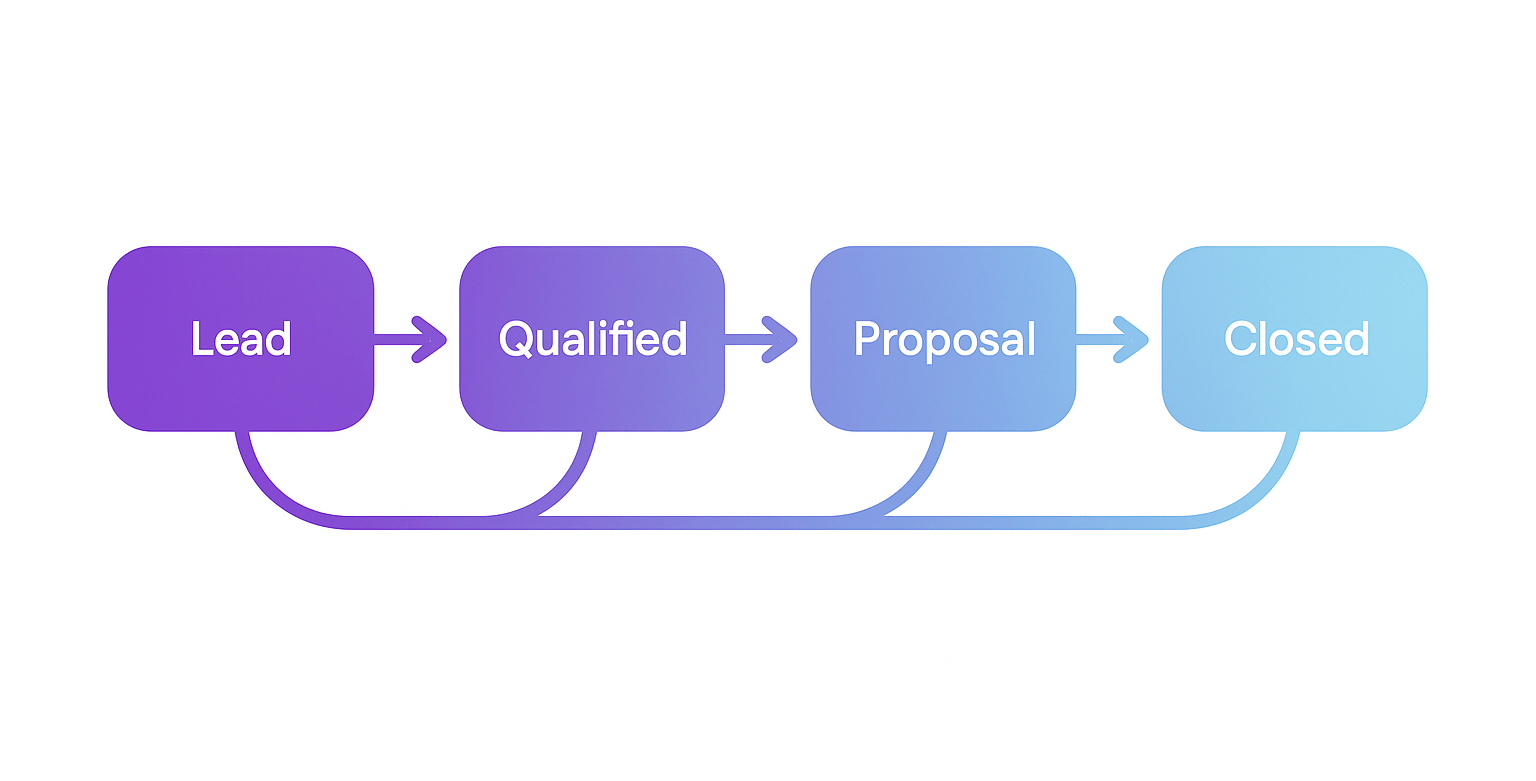
Sales Pipeline Strategies That Actually Drive Revenue Growth
A well-structured sales pipeline is a strategic engine that drives predictable revenue, enhances team productivity, and improves sales forecasting.
Yet, many businesses struggle to construct a pipeline that truly supports their sales efforts.
In this guide, I'll walk through the essential stages of a sales pipeline, show you how to build one tailored to your business, and share best practices for measuring and optimizing it over time.
Core Stages of a Sales Pipeline (With Examples)
While the exact structure of a sales pipeline can vary based on industry, product type, and sales model, most successful pipelines include the following key stages:
1. Prospecting
This is where the journey begins. Sales teams identify potential leads through cold outreach, referrals, networking events, or inbound inquiries. The goal is to create a list of qualified prospects who might benefit from your product or service.
2. Lead Qualification
Not all leads are created equal. At this stage, sales reps assess whether the lead fits the ideal customer profile using criteria like budget, authority, need, and timeline (BANT). Qualifying leads early helps prevent wasted time later in the cycle.
3. Initial Contact
Once a lead is qualified, a sales rep initiates contact — typically through an email, call, or meeting request. This first interaction is crucial for establishing rapport and gathering context about the lead's pain points.
4. Needs Assessment and Nurturing
Through discovery calls, demos, or consultative conversations, reps dig deeper to understand the lead’s needs. Based on this information, they tailor content, resources, and communication to nurture the relationship and move the deal forward.
5. Proposal Stage
At this point, a formal offer is presented. It may include pricing details, solution breakdowns, and terms. This stage often involves several rounds of revision, especially for complex B2B deals.
6. Negotiation
Reps handle objections, negotiate pricing, or adjust scope until both parties reach an agreement. This stage may involve decision-makers on both sides, and momentum is key.
7. Closing
The deal is finalized and signed. The lead officially becomes a customer. But the work doesn’t stop here — successful sales pipelines transition into post-sale support to encourage retention and upselling.
8. Post-Sale and Cold Lead Re-engagement
Effective sales pipelines don’t forget about leads that went cold or customers who’ve already converted. Following up with unresponsive leads can reopen opportunities, while engaging existing clients can lead to referrals and repeat business.
How to Build and Customize Your Sales Pipeline
Building a high-performing pipeline requires a strong foundation based on your sales goals, buyer journey, and internal resources. Here’s a step-by-step process:
Define Your Ideal Customer and Buyer Personas
Start by mapping out your typical customer types. What are their goals, challenges, and objections? Personalizing your pipeline stages based on personas ensures more relevant communication and higher engagement.
List the Pipeline Stages That Fit Your Sales Model
Use the standard stages mentioned earlier as a base, but customize them. For example, a SaaS company might include a free trial phase, while a service-based business might need a scoping or onboarding stage.
Assign Tasks and Owners to Each Stage
Each pipeline stage should have defined actions and responsible team members. For example, BDRs might handle prospecting, while account executives manage proposals and negotiation.
Align With Your CRM and Sales Tools
Your pipeline should be fully integrated with your CRM software. Use tools like Salesforce, HubSpot, or Salesloft to automatically log activities, monitor progress, and track performance across each stage.
Determine Your Average Sales Cycle Length
Knowing how long it typically takes to close a deal helps you better estimate revenue and forecast pipeline health. This also helps in setting realistic follow-up cadences and nurturing timelines.
Best Practices for Measuring and Optimizing Your Pipeline
Even the best sales pipelines need regular monitoring and refinement. Here are some key strategies to keep yours in top shape:
Track Essential Pipeline Metrics
- Number of deals in each stage
- Conversion rate between stages
- Sales velocity (time to close)
- Customer acquisition cost (CAC)
- Win rate (percentage of closed deals)
These metrics provide clarity on which areas of the pipeline are bottlenecks and where improvements can be made.
Leverage Automation and AI Tools
Modern sales engagement platforms can automate follow-ups, identify buying signals (like website visits or email opens), and trigger personalized outreach based on real-time behaviors. This not only saves time but increases deal velocity.
Conduct Regular Reviews
Sales leaders should review pipeline health weekly or biweekly. Identify stale deals, prioritize high-probability opportunities, and coach reps on how to handle obstacles.
A/B Test Strategies
From subject lines to follow-up sequences, continually test your communication strategies. This can significantly improve response rates and help you understand what resonates with your target audience.
Refine Over Time
As your product offerings, team, or market conditions evolve, your pipeline should too. Make pipeline adjustments quarterly or biannually to reflect new business priorities or customer behaviors.
A strong sales pipeline is more than a visual tracker — it’s the heart of a predictable, scalable revenue strategy.
By understanding the right stages, tailoring your process to fit your team, and constantly optimizing based on data, you’ll convert more leads into loyal customers and empower your sales team to exceed their targets.
Whether you're starting from scratch or refining an existing structure, the strategies above will help you build a sales pipeline that fuels long-term growth.
Join 1,000+ CompaniesImproving Email Deliverability
Start with 25 free validations. Upgrade only when you're ready.
No credit card required • Cancel anytime